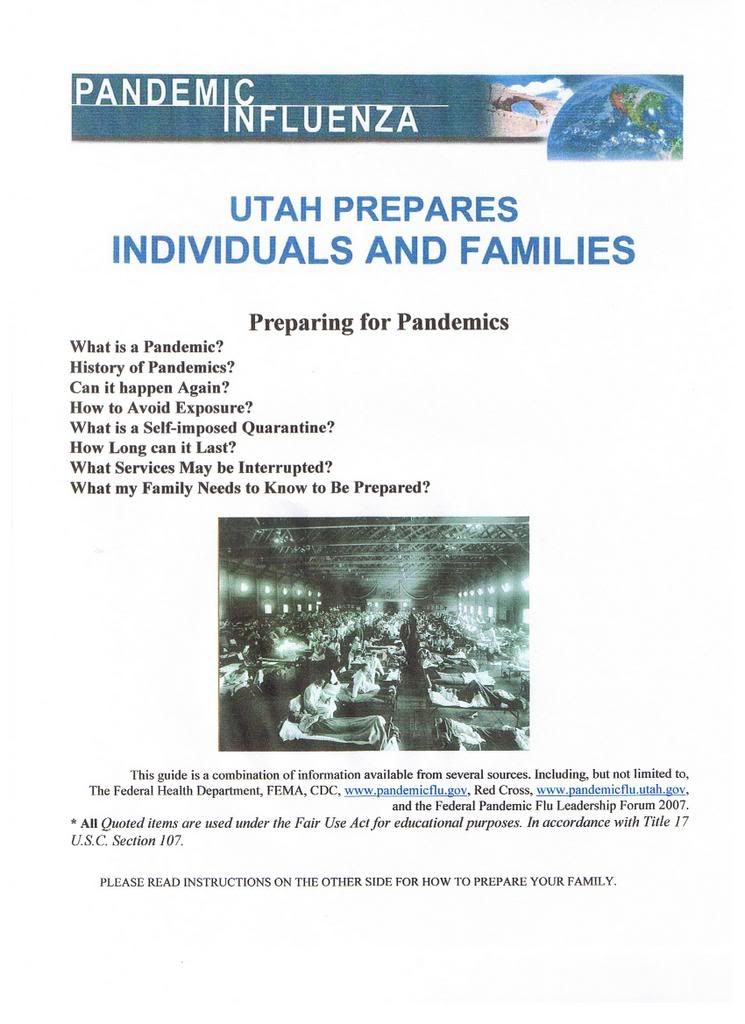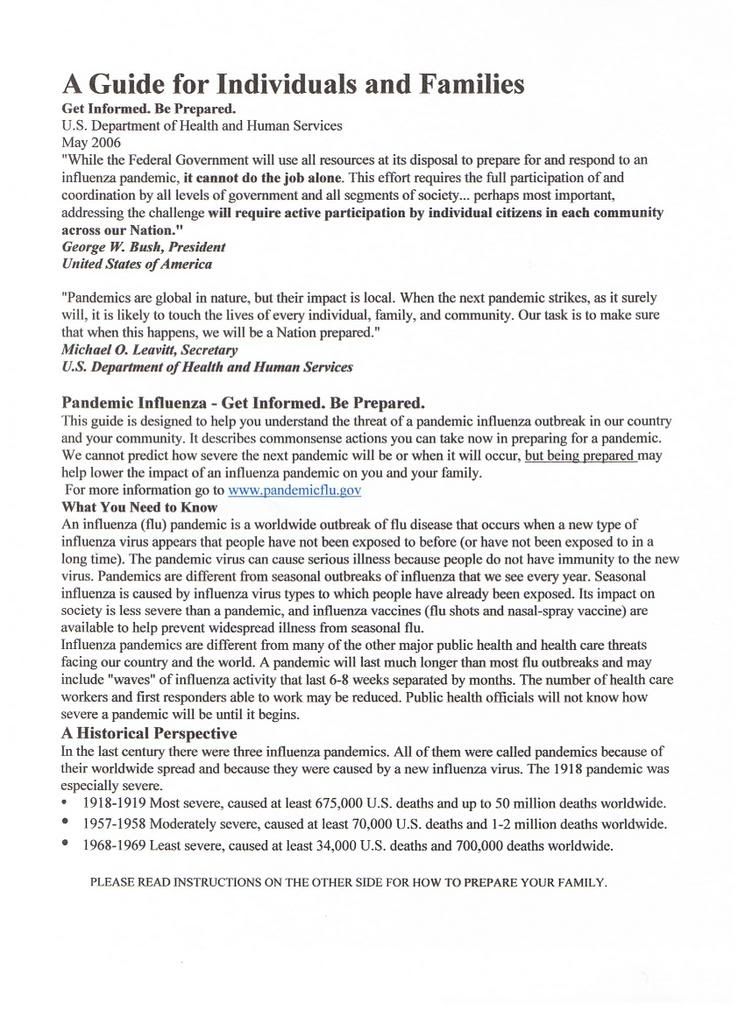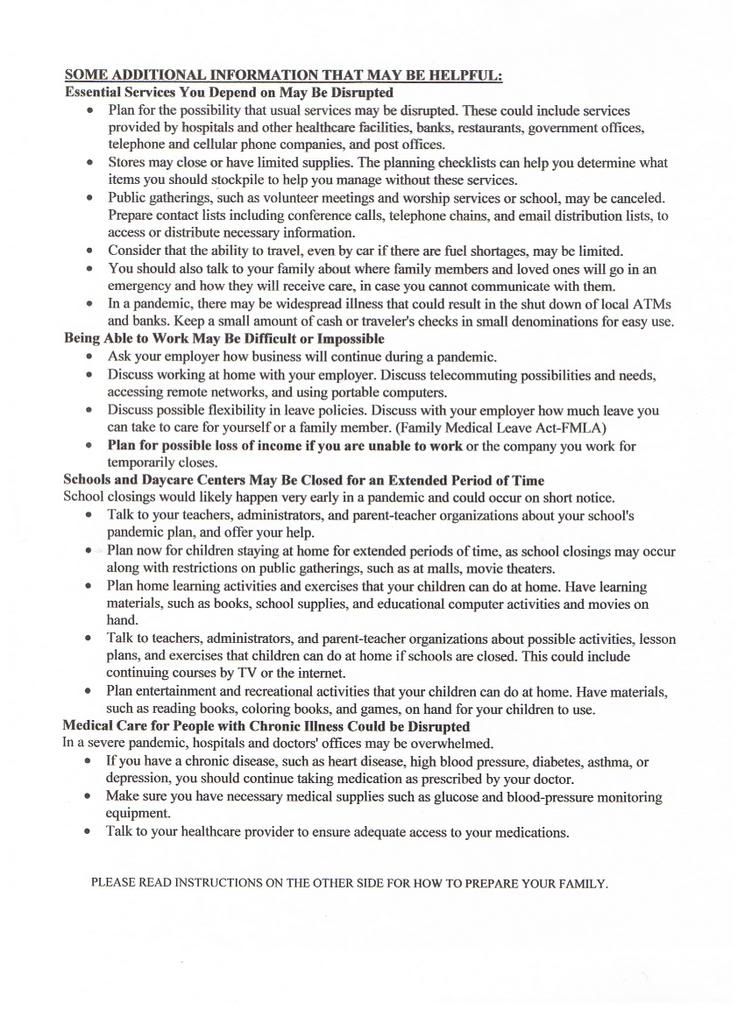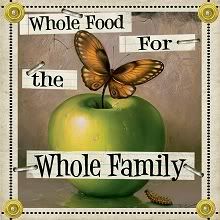By James Wesley, Rawles -- Editor of www.SurvivalBlog.comThe emerging threat of the Asian Avian Flu Virus (AAV H5N1) brings into sharp focus the vulnerability of modern, highly mobile and technological societies to viral or bacterial infectious diseases. The last major Asian flu outbreak, (H2N2 in 1957, which killed 69,800 people in the United States) took five months to reach the United States. With the advent of global jet travel, it is now likely that highly virulent disease strains will be transmitted to population centers around the world in a matter of
just a few days.
In this article, I will describe how you can protect yourself and your family from the next great pandemic. Although the likelihood of AAV H5N1 mutating into a strain that can
easily be transmitted between humans is relatively low, the potential impact
if this were to occur would be devastating. The current strain of the virus has a
58% lethality rate for humans. But even if AAV H5N1 turns out to be a "non-event", in the next few decades there is a very high likelihood that some other disease will emerge and suddenly make a pandemic breakout. The odds are against us, because influenzas have tendency toward antigenic shift. Because influenzas are viral and are spread by casual person to person contact, the majority of the world's population will be exposed in just a few weeks or months. Even today, more than 30,000 Americans die each year from flu complications--mostly the elderly and those with compromised immune systems.
Here are the key things that you need to do to protect yourself and your family, and to help restore order during a pandemic:
A.) Raise Your Immune Resistance
B.) Be Ready to Fight the Illness
C.) Avoid Exposure.
D.) Stockpile Key Logistics.
E.) Be Prepared to Dispense Charity From a Safe Distance
I will briefly discuss each of these requirements in this article. I will also be posting more detailed follow-up articles on each topic in my daily blog (web journal) at
http://www.SurvivalBlog.comRaise Your Immune ResistanceThere are two philosophies to fighting off influenza viruses. The first and mostly prevalent is to raise the body's immune response. The other is to maintain normal immune response to prevent a collapse caused by over-response--a so called "cytokene storm". While opinion is divided on this issue, I tend toward a strong immune response--particularly if combating a highly virulent illness.
To raise your immune resistance to disease it is important that you stop smoking. If you are a smoker you have already realized that you are much more susceptible to respiratory infections. Smokers are at high risk to develop complications. Get plenty of exercise, eat healthy foods, drink only in moderation, get plenty of sleep, and use top quality vitamin supplements (from a company such as
eVitamins.) If you are overweight, you need to alter your diet get down to within five pounds of normal body weight. You need to change your diet for two important reasons: First, unhealthy foods weaken your immune system. Cut out refined sugar. Avoid candy, snack foods, soft drinks, and any processed foods with preservatives, artificial sweeteners, or
MSG. Avoid store-bought meat, which is often tainted by the hormones and antibiotics used in commercial livestock feeds. Wild game or home-raised livestock is much healthier! Lastly, pray. Why? Anxiety is a form of stress that weakens the immune system, and prayer is a proven way to relieve anxiety and stress. And more importantly, as a Christian I believe that it is crucial to pray for God's guidance, providence, and protection.
Be Ready to Fight the IllnessThere are some symptoms that distinguish between colds and flus: Flus typically cause fever, chills, achy feeling (malaise), headaches, and extreme fatigue. Cold symptoms are usually restricted to the upper respiratory tract while flu symptoms tend to involve the entire body.
Influenzas tend to kill most of their victims in two ways: dehydration and lung congestion. Even the Avian flu, which is respiratory usually starts with stomach flu symptoms. Stomach flus usually induce diarrhea which rapidly dehydrates the victim. To fight this, you need to stock up on both anti-diarrhea medicines (such as Imodium AD--an anti-spasmodic) and electrolyte solutions such as Pedialyte. (The latter is available in bulk though large chain "warehouse" stores.) The various sports type drinks (such as Gatorade) can be used as oral rehydration solutions (ORSs) too. However, I prefer to dilute them about 50% with water, they have a lot of glucose in them which will exacerbate diarrhea symptoms.
If commercial ORSs are not available, I have read that you can make an emergency solution as follows:
• 1/2 teaspoon of salt
• 2 tablespoons honey, sugar, or rice powder
• 1/4 teaspoon potassium chloride (table salt substitute)
• 1/2 teaspoon trisodium citrate (can be replaced by baking soda)
• 1 quart of clean water
Imodium is a trade name for Loperamide. It can be purchased generically for relatively little cost, at such places as warehouse stores. The generic (house brands) are just fine. Stock up on Acetominophen (Tylenol) and Ibuprofen (Motrin) as well - for treating fevers. These two antipyretics can be taken together or on an alternating 4 hour schedule (take each every 4 hours but split them, for example at 8 AM take acetaminophen, at 10 AM take ibuprofen, etc. This makes it easier to monitor the patient and get them to drink fluids, if they're up every 2 hours they will have to drink some fluids). Either have a traditional glass thermometer for each person, or a digital thermometer with lots of disposable sleeves. The thermometers are a couple of bucks at the stores mentioned above. The sleeves are a buck or so per hundred. Don't cross-contaminate your patients.
Because influenzas are viral rather than bacterial, most antibiotic drugs (antibacterials) are useless in combating them. If you suspect that you are coming down with influenza get bed rest! Too many people ignore their symptoms because "that project at work just has to get done." Not only do they risk their own health, but they infect their co-workers! Liquids help ease congestion and loosen phlegm and are of course crucial to rehydration. Just a fever alone can double your body's dehydration rate.
Respiratory flus such as the Asian Avian Flu kill with congestion. Buy a steam-type vaporizer. Stock up on expectorants containing guaifenesin as the main ingredient.
You will need to watch carefully for any symptoms of pneumonia develop. These include: difficulty or painful breathing, a grunting sound when breathing (quite distinct from the wheezing of bronchitis or the "barking" of croup), extremely rapid breathing, flaring nostrils with each breath, or coughing up rust-colored phlegm. Pneumonia can be a deadly complication of the flu and is the main cause of flu-related death. It is important to note that
pneumonia is typically a co-infection that can be either viral or bacterial. In case of a
bacterial pneumonia, antibiotics are crucial for saving lives. If it is viral, there is not much that can be done. While antibiotics can clear infection they cannot remove secretions. The patient must cough them all the way back up the respiratory tract. Do
not use cough suppressants--anything with active ingredients like dextromethorphan or diphenhydramine. A "productive" (wet) cough that produces phlegm is a good thing! This is where you may need expectorants. One that works well is Robitussin (the original type of Robitussin without any capital letters after the name). These are also available as generics, and quite cheap, so stock up. You should also read up on postural drainage and percussion techniques for chest secretion clearance--for instances when your patient cannot or will not cough effectively.
Avoid ExposureAside from being actually coughed or sneezed upon by an infected person, the most common way to catch the flu is by touching something which has been coughed on or sneezed upon by an infected person. For instance, the person that used the shopping cart before you had the flu. They covered their mouth with their hand when they coughed then used that very hand to push the cart around the store. Now your hands are touching the same place. Without thinking while shopping, you rub your eye or nose and you have introduce the virus to your most vulnerable point of infection. When you are out in public do NOT touch your eyes or nose. Wash your hands frequently to remove any germs you have picked up. Teach your children this as well.
Even though the chances of a full scale "nation busting" pandemic are small, the possibility definitely exists. The recent public statements by President Bush about considering the use of the military to enforce an Asian Avian flu pandemic quarantine are indicative that government officials are taking the threat seriously. A full scale pandemic that starts taking lives on a grand scale may then reasonably cause you to take some extreme measures to protect the lives of your family members. You can
cut your chances of infection by more than half if you prepare to live in isolation (a strict "self quarantine") for an extended period of time. You need to be prepared to avoid all contact with other people during the worst of the pandemic.
The self quarantine period might last as much as three years, as successive waves of influenza sweep through the country. Think this through, folks. What would you need to do to successfully quarantine your family? Grab a clipboard and start making some prioritized lists.
History has shown that infectious diseases do their worst in urbanized regions So if you can afford to, make plans to move to a lightly populated region,
soon. Where? Read my blog (
http://www.SurvivalBlog.com) for some detailed recommendations, but in general, I recommend moving west of the Mississippi (because of the west's much lighter population density) to a rural, agricultural region. When looking for a retreat locale, look outside of city limits and away from major highways that will serve as "lines of drift" for urban refugees. You are looking for a property that could serve as a self-sufficient farm--something over five acres, and preferably closer to 40 acres. In the event of a "worst case" pandemic situation, there is the possibility that power grid could go down. Even if your farm has well water, you may be out of luck. A home with gravity fed spring water is ideal, but uncommon. So you will either need to be able to pump well water by hand--only practical with shallow wells--or
be prepared to treat water that you'll draw from open sources: rivers, creeks, lakes, or ponds.
Plan to live at your retreat year-round. In the event of a full scale pandemic, the police and military will probably be ordered to enforce draconian quarantines of cities, counties, or perhaps entire states or regions. Having a well-stocked retreat is useless if you can't get to it.
Live there, and become accustomed to getting by self-sufficiently. Plant a big vegetable garden, using non-hybrid seeds. Raise small livestock that can forage on your own pasture. Get your digestive system accustomed to consumption of your bulk storage foods. Home school your kids. Develop a "hunker down" lifestyle with minimal trips to town. Each trip to town will constitute another opportunity for infection.
To make self-quarantine effective, it is essential that you are prepared to live in isolation for many months, and possibly years, to avoid contact and subsequent risk of infection. This can be practical for anyone that is retired or self-employed in an occupation that does not require regular face to face contact with clients or customers. (For example home-based mail order, self-publishing, recruiting, medical/legal transcription, or telecommuting.) But for anyone else it may mean having to quit your job and live off of your savings. So it is essential that you get out of debt and start building your savings, ASAP. If you can possibly change jobs to something that will allow isolation or semi-isolation, do so as soon as possible. For most of us in the middle class, this may mean "doubling up" with another family to share resources.
To protect yourself (at least marginally) from infected spittle, wear wrap-around goggles and buy or fabricate surgical style masks, in quantity. Note that
even an N100 gas mask filter will not stop an airborne virus, since the viruses are too small. But at least a cloth mask will give you some protection from virus-laden spittle. Once the pandemic breaks out in your region, you won't look out of place wearing these, even on a trip to the post office. Stock up on disposable gloves. Note that some individuals are allergic to latex. So do some extended wear tests before you buy gloves in quantity. Wear gloves whenever away from your retreat, and wash your hands frequently, regardless. Keep your hands away from your nose and eyes at all times. Stock up on soap and bottles of disinfecting hand sanitizer.
Stockpile Key LogisticsTo make long term self quarantine effective you will need to buy a large quantity of long term storage food from a trustworthy vendor. Storage food is bulky and expensive to ship, so plan to buy locally or rent a truck and travel to a nearby state to pick up your storage food. In the eastern U.S., I recommend Ready Made Resources, of Tennessee. (See:
http://www.ReadyMadeResources.com) In the western U.S., I recommend Walton Feed of Idaho. (See:
http://www.WaltonFeed.com) It is also important to
lay in extra food to dispense in charity--both to your neighbors and to any relatives that might end up on your doorstep at the 11th hour.
Stockpile fuel--firewood, home heating oil, or propane, plus fuel for your backup generator, vehicles and/or tractor. For liquid fuels, buy the largest tanks that you can afford to buy and fill, and that are allowable under your local fire code. If you heat with wood or coal, determine how many cords or pounds of coal you buy each winter and then
triple that amount.
Build a sturdy gate to your driveway and get in the habit of keeping it closed and locked. It may sound far-fetched, but in the event or a "worst case" you may have to repel looters by force of arms. Buy plenty of ammo, zero your guns, and practice regularly. Hurricane Katrina showed how fragile our society is and how quickly law and order can break down in an emergency. Plan accordingly.
With the consent of your doctor and his prescription, you should stock up at least moderately on antibiotics such as penicillin and Ciprofloxacin ("cipro") to fight
co-infections. But they should
only be used if it is abundantly clear that a co-infection has set in. (Again, watch for pneumonia symptoms.)
There are a few drugs that have been clinically proven to be useful in lessening the symptoms of viral influenzas, and shortening the duration of illness. These include
Relenza (Zanamivir),
Tamiflu (Oseltamivir phosphate), and
Sambucol. These drugs are used immediately after the onset of flu symptoms. Of the three, Sambucol--a non-perscription tincture of black elderberry-- is probably the best. I predict shortages of these drugs in coming months, so
stock up while they are still readily available!Be Prepared to Dispense CharityFrom a Safe DistanceI already mentioned that it is important to
lay in extra food to dispense in charity. I cannot emphasize this enough. Helping your neighbors is Biblically sound and builds trustworthy friendships that you can count on. To avoid risk of infection, you need to be prepared to dispense charity from a safe distance--without physical contact. Think: planning, teamwork, and ballistic backup. While your family's food storage can be in bulk containers (typically 5 to 7 gallon food grade plastic pails), your charity storage food should mostly be in smaller containers. Or, at least buy some extra smaller containers that you can fill and distribute to refugees. Also be sure to lay in extra gardening seed to dispense as charity. Non-hybrid ("heirloom") varieties that breed true are available from several vendors including The Ark Institute. (See:
http://www.ArkInstitute.com). By dispensing charity you will be helping to restore order and re-establish key infrastructures. The bottom line is that you'll be part of the solution rather than part of the problem.
In closing, I highly recommend that you read
Dr. Grattan Woodson's monograph "Preparing for the Coming Influenza Pandemic", available for free download at my blog site. Also see:
http://www.fluwikie.com.Postscript from SurvivalBlog.com Reader and Contributor "Dr. November":I'm not a big believer in Tamiflu (Oseltamivir) or the other neuraminidase inhibitors. It's only demonstrated effect is to make the course of the flu slightly less long (on the order of 1-2 days less), but it has a critical requirement: IT MUST BE TAKEN within the first day or two of feeling ill. Most people (myself included) will just feel a little 'off' those first couple of days, or try to work through it. Tamiflu in this situation is pretty useless. Also, if someone is going to use it, they MUST have it on hand before they get sick: Getting the first symptoms, then deciding to call your physician and getting an appointment to get the prescription the week after next isn't going to help. Finally, it's pretty expensive (a standard 5 day adult dose is around $100 plus the physicians appointment). It's also going to be in short supply as people start trying to get it (similar to Cipro following the anthrax attacks and scares). BTW, Mom's old standby for respiratory infections (chicken soup) is as effective as oseltamivir. I doubt that it would be a good choice for an avian flu pandemic, though.
I was favorably impressed with a study done in Israel about the efficacy of Sambucol. At least, it's not expensive and won't hurt anything.
So, what should people do? In addition to the suggestions you've offered, I have a few more: If the pandemic strikes, and you can't avoid going out among people, wear disposable gloves (they don't have to be surgical or sterile). You don't know who last touched that ... whatever (door knob, elevator button, etc). Carry and use several pair, and learn how to take them off without touching the outsides (ask a medically trained individual to show you).
Keep your hands away from your mouth, nose and eyes! If your hands become contaminated, don't transfer the virus to mucous membranes. Wash your hands often (and also, BEFORE and AFTER using public restrooms, then don't touch the door knob on the way out - use an extra paper towel). Hand sanitizer gels are OK but plain soap and water is fine too. If nothing else is available, a 'dry wash' (vigorously rubbing your hands as though you were soaping them up) is surprisingly effective in removing the outer dead layer of skin cells that harbor virus particles or bacteria. It won't get rid of every single one (nothing will) but it's a matter of odds - the fewer, the better.
Teach everyone (especially the dear little germ transport mechanisms we call children) to cough into their elbow or armpit - NOT to cover their face with their hands (and then what?) or use a tissue (and then what?). And to wash their hands afterwards.
I can commend a medical blog that has an excellent article (and link to a free New England Journal of Medicine article) on avian flu:
http://medpundit.blogspot.com/2005/10/flu-bug-variations-everyone-seems-to.html and
http://content.nejm.org/cgi/content/full/353/13/1363 - Dr. November
Disclaimer: I'm not a doctor, and I don't give medical advice. Mention of any medical device, treatment, drug, or food supplement is for educational purposes only.
Consult your doctor before undertaking any treatment or the use of any drug, food supplement, or medical device. SurvivalBlog.com is not responsible for the use or misuse of any product mentioned.Copyright 2006, 2007. All Rights Reserved by James Wesley, Rawles - www.SurvivalBlog.com
™ Permission to reprint, repost or forward this article in full is granted, but only if it is not edited or excerpted.
About the Author:James Wesley, Rawles is a former U.S. Army Intelligence officer and a noted author and lecturer on survival and preparedness topics. He is the author of the novel "Patriots: Surviving the Coming Collapse" and is the editor of SurvivalBlog.com--the popular daily web journal for prepared individuals living in uncertain times.






